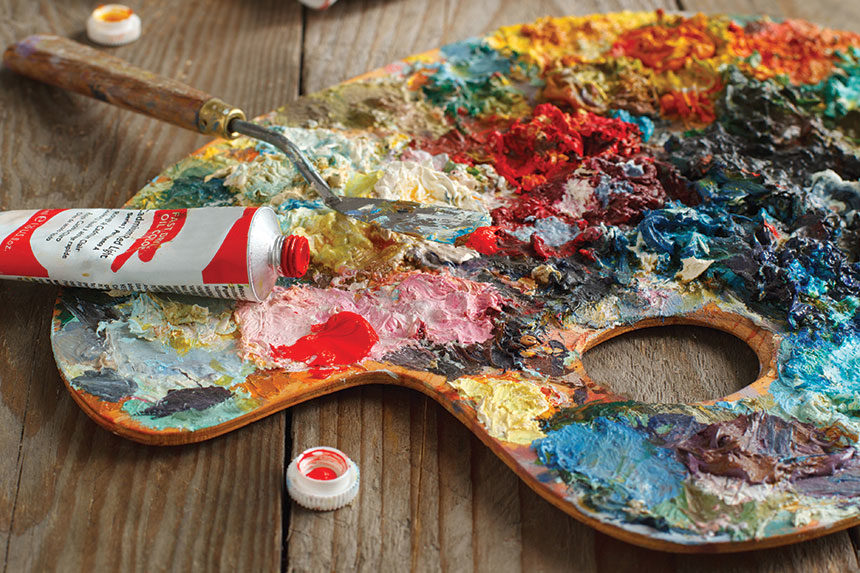Ellert Gayle had lived above the shop on Fillmore Street when it was a hat shop, then a pet-bird shop, then a fancy cooking oils and spices shop, and now a shop where women went not to have their hair cut, just blow-dried. The apartment was rent stabilized with an absentee landlord, who had retired decades earlier to the Southwest and sent his adult children every month to pick up the checks from the locked metal box on the wall of the narrow lobby. Nobody had bothered to renegotiate leases or raise the rent more than a few dollars in years. Ellert could never have afforded to move, even if he’d wanted to. Unintentionally and without his being fully aware of it, he had come to represent the last gasp of a dying breed in the West Coast’s most expensive city, on a street once dominated by art galleries, studios, and performance spaces — where hip ready-to-wear brands now took a loss on exorbitant leases for the cachet of the address.
Ellert Gayle was a painter.
He cut a well-known figure in the neighborhood where he had lived for four decades. He still had the thick mop of unruly hair befitting an artist, now a steely gray, and although his clothes were mostly army surplus and flecked with paint, he wore them with his own shabby panache. On a braided silk cord around his neck hung a frog carved of bone, found at a Tibetan gift store in the Haight. The frog was satisfying to him somehow — its curving weight bouncing softly against his chest as he walked — but he couldn’t say how exactly. Its eyes were closed.
Nearly as legendary as Ellert himself was the painting he had been working on for as long as anyone could remember. Every Fillmore Street regular had heard of the painting but, to the best of their knowledge, nobody had actually seen it. Among the locals there was strong, almost gleeful disagreement over whether or not it actually existed. Newcomers were deemed initiated when someone saw fit to relate to them the backstory of Ellert and his fabled painting — and were judged on their response.
Beyond dispute was the fact that Ellert really did paint; he’d shown several pieces at the Hughes Gallery that everyone in the neighborhood had gone to see, hoping for a big reveal. Marie-Claude, who owned the ikebana florist and volunteered in the cattery of the SPCA up the street, had even bought one. It was prominently displayed behind the counter of her shop, over a bonsai juniper tree. But this painting was small — two feet by two feet, if that — and covered in dark waves that radiated out from a pinpoint somewhere near the center. A handsome piece, but hardly on par with the mythical opus.
It was commonly understood that Ellert woke early, crossed the street for coffee and sometimes a pastry or an egg sandwich at the coffee shop on the corner, then returned to his studio (otherwise known as his apartment) to “work” from midmorning through late afternoon. He’d go out again in the evening for a long walk before dinner — usually in his small but serviceable kitchen, but occasionally as the guest of an affluent friend at one of the half-dozen or so Continental bistros scattered along as many blocks. On holidays his schedule might vary slightly (he never seemed to go out of town), but for the most part he was a rare constant in a neighborhood and a city that money and power and influence were almost constantly altering for their own benefit.
“How’s the painting going, Ellert?” asked Jake, one of the morning baristas at the coffee shop. He liked Ellert a lot but didn’t believe there really was a painting.
“How’s the painting going?” asked Vincent, the retired estate and trust lawyer who drank his coffee on the bench in front of the coffee shop every morning and certainly didn’t believe there really was a painting. Not by that layabout.
“How’s the painting going, El?” asked Dave, the finance guy who never actually seemed to work, just drive his convertible between the coffee shop, the park up the hill with the incredible view, and the upscale Italian restaurant down the street. He didn’t really care whether there was a painting or not, as long as Ellert was around to laugh at his jokes and enhance his image of himself as a bohemian — two skills that were rare enough and more valuable to Dave than any painting.
“Ellert! How’s the painting going?” asked Mark, who worked at the bookstore next to the coffee shop and wanted, from deep within his generous nature, to believe that there really was a painting, but having known his share of artists over the years, he wasn’t so sure. Sweeping the leaves that the overnight wind had blown into the bookstore’s doorway, he watched Ellert cross the street in the middle of the block — waiting deferentially for the 22 bus to pass, while ignoring the swarms of rideshare drivers swerving and parting to avoid his unhurried pace.
But there really was a painting.
When he reached the front door of his apartment, he paused, delaying for a moment the faint surge of joy he still felt whenever he returned and found it waiting for him. Ellert Gayle had been working on the same painting since the early 1980s. When he tallied it up like that it sounded absurd, even to himself. Long ago he had noted with laughter when the painting was old enough to vote, then drink. Sure, he’d done other things between then and now — little dimensional canvases and abstract, actiony pieces that had sold much quicker than he’d expected at Joseph Hughes’s gallery, the only holdout from the street’s creative past. Hughes also edited the hyper-local Fillmore Street paper, which had been reduced from weekly to monthly and continued to exist largely on his charity. Hughes had run a few articles on Ellert over the years, but in each accompanying photograph the painting was conspicuously missing. When, occasionally, someone asked the gallerist about it, he demurred, allowing the questioner to make assumptions — but he had not, in fact, ever seen the painting.
Ellert never let anyone, not even Joe Hughes, into his apartment. At first this reclusion had stemmed from a sense of modesty and mild superstition — not wanting anyone to see his work before it was “ready” — and now it was simply a matter of habit. He spent plenty of time playing his role on the neighborhood stage and mostly enjoying it, but his home was private.
He got good light from late morning through the middle of the afternoon through the large, rectangular bay window facing the street. The painting leaned against the long south wall bordering the building next door, held in place by two large cans of turpentine on a drop cloth to protect the original softwood floors. Bright bands of sunlight flowed across its meticulously layered surface. He kept a small wooden step stool — a relic of his grandmother — for working from the top of the canvas and, later, for sitting when he found he couldn’t stand or bend down for as long as he used to. His paints, brushes, palettes, and other tools sat on a rolling metal utility cart picked up for free when one of the neighborhood’s many failed restaurants had to vacate its premises quickly. The restaurant business was a hard business, Ellert thought; he was glad he wasn’t in it. But he appreciated the cart, which had replaced an old Formica TV tray long on the verge of collapse.
Here he spent hours adding to — and sometimes subtracting from — this substantial canvas, carefully considering each familiar angle and proportion. By now, Ellert figured he could probably copy the painting blindfolded or in the dark. But intimacy was not the same as understanding, and even after so long, he still felt that something was missing. Some essential aspect of this work still evaded him, and he had no regrets about spending as much of his time as necessary to find it.
Nobody had seriously questioned Ellert about the painting for years. It seemed rude to do so, beyond rude — a rip in the space-time continuum, a disruption of the natural order of things. Everyone liked Ellert Gayle, more or less, and even those who were lukewarm on him or particularly disbelieving had no desire to break the spell his painting held over the neighborhood.
So it came as a surprise when Robert Wellman began making what sounded like earnest inquiries of those who knew Ellert best. He had recently become a member of the modern art museum’s prestigious board and was eager to impress. Like everyone else, he’d heard stories of the painting for what seemed like forever and had largely ignored them. But since joining the board, he’d found himself wondering what the odds were that he was gazing at an unknown masterpiece each time he sat at the window counter of the coffee shop facing Ellert’s apartment across the street. Long odds, he wagered — no harm in testing them.
Marie-Claude had just added a second painting of Ellert’s to what she called her “local collection” — Robert had seen it when he’d ordered the birthday arrangement for his wife. It wasn’t a bad little painting, not bad at all. Like early Rauschenberg … really early. He cornered Joe Hughes one morning getting his coffee. He and his wife had known Joe practically since they’d moved to the neighborhood, almost as long as Ellert had lived there. Granted, the Wellman residence was a mansion up the hill, not an apartment above a blow-dry bar — but, Robert reasoned, the painter wasn’t the only one with some local cred around here.
“I mean, you represent Ellert, if anyone does … don’t you?” he asked the gallerist.
“I suppose so.” Joe was reluctant to commit. He had never really discussed it with Ellert — the idea had seemed absurd, so unnecessary. When he showed a small painting or group of paintings, he worked out the prices in advance with Ellert, who always agreed to whatever Joe suggested. Of anyone in the world besides Ellert himself, Joe Hughes was in the best position to say whether or not the infamous painting existed. On good days, when Ellert promised him two or three modest works for the spring catalogue, he thought it might. On bad days, when Ellert refused to return his calls, he was sure that it didn’t.
“We don’t have a formal agreement.”
“But, you’ve had all his paintings. …” Robert hesitated. “That we know of.”
“That’s true.” As far as Joe could tell, Ellert had never sold a painting anywhere else. At least, not since he’d lived on Fillmore Street.
“So, you’d be the one to get me in to see it,” Robert concluded, his real estate developer’s tone kicking in.
“I don’t know, Rob. Ellert’s funny that way.” Joe wasn’t sure what to say to his old friend, whose aesthetic sensibility was undeniable, but who seemed to view art like new property hitting the market. In the end, however, he promised to try.
When Joe Hughes had approached him about seeing the painting — he had said it almost in a whisper — Ellert’s first instinct had been, of course, to refuse. But lately he’d been feeling a sort of restless agitation with it, hardly adding more than a stroke or two in an entire day’s work. He’d had setbacks before, and occasionally over the years he’d scraped small sections of the canvas clean to start over, but never had he done so little so slowly. He was on the verge of a breakthrough, he knew — the real painting, the one that had been trying to reveal itself to him for such a long time, was almost within reach. Perhaps, he reasoned, he needed to see it through someone else’s eyes to clear the dust from his own. Then he could finally, finally get it right.
And so he stunned Joe by saying sure, come on by, bring your buddy Robert Wellman and someone from the curatorial staff at the modern art museum. Why the hell not. Which is how the four men found themselves in the spotless, spartan living room, the smalls of their backs pressed against the half wall separating the eat-in kitchen, standing as far away as they could to get a decent view of Ellert’s painting.
This certainly puts to rest any question of the painting’s existence, thought Joe. It emphatically, massively existed. He and Rob had taken a risk, bringing the curator here without coming to check it out for themselves first, but Joe didn’t know if he could secure a second visit, and the curator had assured them ahead of time that he’d been on far stranger adventures for the sake of contemporary art. Perhaps, he’d suggested over the phone, if there was no actual painting, Ellert might consent to documenting his decades-long charade as a kind of performance art … ? Joe was horrified by this suggestion, but he bit his tongue. And thankfully it hadn’t come to that after all.
There was a long, long silence.
“Remarkable. Absolutely extraordinary,” the assistant contemporary art curator pronounced at last. This was turning out to be more than just a favor to please a wealthy board member. Half his studio visits in the past few months had been made on the insistence of still-pimply tech millionaires, to the basements or garages of some “friend” who invariably turned out to be a middling graffiti artist.
“Of course, I’ll have to run it by the head of contemporary, maybe even bring him back to see it, but …” His voice trailed off as he looked the painting over. It was enormous, nearly the size of the main room of the apartment. Even against the opposite wall, he could hardly take it in. The eyes boggled, let alone the mind. He had no idea how this man had even gotten the canvas in here — some 30-odd years ago, he was told — let alone created … this. Maybe he’d built the frame, stretched the canvas himself.
“What’s it called?” the curator finally asked, when the others remained silent.
“The Star.”
The museum offered to purchase The Star for an amount that, at first, Ellert assumed must be a mistake. The assistant contemporary art curator had to get on the phone himself and assure the painter that they were serious. It would be removed from his apartment by professional art handlers, installed in its own special exhibit, and Ellert could pick up his check. He felt so strange, being at home and not working on the painting, thinking of it as “finished.” At the very moment he’d imagined himself on the verge of understanding it perfectly, he instead wondered if he’d ever understood it at all.
Now, he tried to spend as much time away from the neighborhood as possible, worried someone might ask him for details about the painting, the sale. The news of its existence had spread almost immediately — Ellert wasn’t sure how. Both Joe Hughes and Robert Wellman had pledged their silence, and the curator was a disinterested third party with no reason to gossip. (Joe had seen Rob’s effusive post about it right after they left the apartment, but Ellert didn’t have a computer or smartphone, let alone social media accounts, so the source eluded him. At least Rob hadn’t managed to take a photo.)
With nothing else to do, Ellert went to the museum to watch the painting’s new home being built — a large alcove where it would look down upon the viewer from its illuminated plane like a religious icon. He tried to imagine it here, but he couldn’t. He’d seen it for too long in his own apartment, where it struck him as homey and inviting, smaller than its actual size. Here the painting would be easier to see and appreciate … but remote. Afterward, he lingered in the museum’s rooftop sculpture garden, then in the park across the street, surrounded on all sides by the city’s busy downtown. He tried to shut out the noise and appreciate the clever, modern design of the park, with its many-leveled path over a sunken water feature. Pressed against his chest, the bone frog opened its eyes.
The day that The Star was supposed to be moved, it rained. The museum called Ellert with their apologies. The handlers would be there the next day instead. They arrived promptly on schedule, a team of five experts with strong builds and neutral, uniform clothing. They assessed the doorframe at the residential entrance to Ellert’s building, the narrow lobby, the internal staircase that curved slightly as it rose to the second floor, the long hall leading to Ellert’s front door. When he let them in and they saw the painting, he was sure he heard a skeptical murmur pass among them. Measuring tapes both flexible and taut emerged from secret pockets in the handlers’ workmen’s garments, gauging the painting from every angle. The doors were measured, the hallway, the stairs. The painting was measured again. Its frame was examined — no way to detach the painting without destroying it. The canvas, once pliant, was now entirely rigid and stiff from age and the long accumulation of paint. The wood behind it was dry and unyielding.
The team of expert handlers shrugged in defeat. They couldn’t move it.
The crane came the day after that, very early in the morning to minimize traffic. The museum had paid the city’s premium for overnight installation of the no parking signs now posted in front of Ellert’s building. Unlike the art handlers, who had parked their unremarkable panel van discreetly around the corner, these signs — not to mention the crane, which was impossible to miss — had tipped off the neighborhood. A small cohort of locals, up early enough to figure out what was going on, had gathered across the street. They texted their neighbors, and soon a crowd had gathered. They spotted Ellert outside the entrance to his building. Robert Wellman positioned himself proudly in his favorite seat at the window counter, his responsibilities in this matter having already been fulfilled.
The wooden frames, still fitted with early-20th-century glass, had been removed at the hinges from Ellert’s bay window. Two crane men were covering the painting with a complex web of netting, to which the main hoist line would be hooked. The third was operating the machine itself. Carefully, one man maneuvered the crane’s yellow arm into the yielding gap at the front of Ellert’s apartment. On a verbal signal from the first two, the third crane man eased the painting forward. It cleared the window and for a moment it hung in the clear morning air — like an honest-to-God star, thought Ellert poetically. Then, swiftly and without hesitation, The Star broke loose and fell to the ground, carried by its own massive gravity. It shattered into pieces on the pavement below.
Again the museum called with their apologies, which sounded sincere enough to Ellert. They had done him the favor of disposing of the rubble. Of course, the check was out of the question now. He had insurance, they had no doubt. The crane company had insurance, they imagined, as well. They gave him the number. With the sound of the blow-dryers humming beneath him, Ellert set a large blank canvas — nearly reaching the ceiling — against the long wall of his apartment. He hadn’t even known that it was possible to take out insurance on your own unfinished painting. A strong midday light was streaming in through the bay window. He picked up a clean trowel from his bench, dipped it in oils, and began to compose.
E.C. Messer lives in San Francisco and Pismo Beach, California, with her husband and four cats, one with a bionic heart. Her work has appeared in Columbia Journal, Faultline, and the Denver Quarterly, among others. Follow her on Instagram and Twitter @ecmesser.
This story first appeared in the Catamaran Literary Reader. It is featured in the May/June 2020 issue of The Saturday Evening Post. Subscribe to the magazine for more art, inspiring stories, fiction, humor, and features from our archives.
Featured image: Shutterstock
Become a Saturday Evening Post member and enjoy unlimited access. Subscribe now



